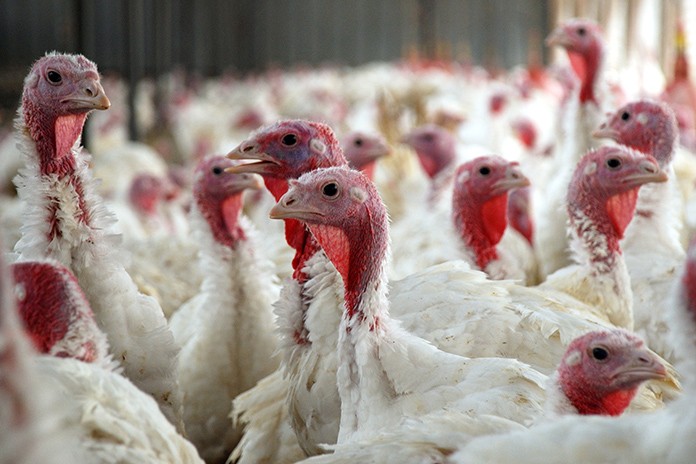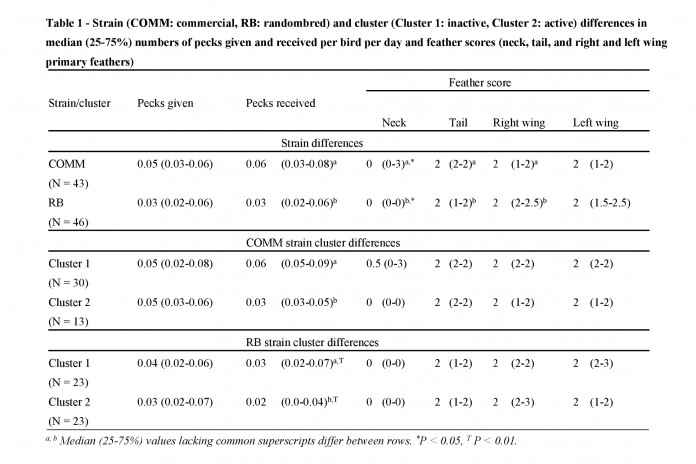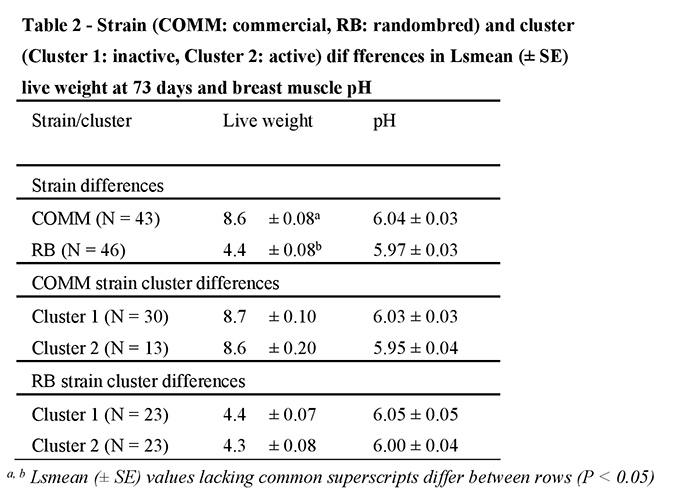
Fear is defined as a reaction to danger or an “adaptive state of apprehension to an imminent threat” (Davis et al., 2010). Fearfulness refers to how susceptible an animal is to being frightened. Individuals differ in fearfulness, which impacts whether individuals are able to cope with challenges in their environment. Animals that are more fearful have increased physiological responses to stressors compared to less fearful animals and differ in other economically important behaviours.
For example, individual differences in fearfulness play an important role in the development of feather pecking in laying hens. Feather pecking, (the pecking at, plucking and sometimes removal of feathers from conspecifics) is one of the main welfare problems of commercial turkey production, but this abnormal behaviour is poorly understood. To date, there has been scant research examining whether individual differences in fear responses are related to feather pecking of turkeys.
Individual differences in fearfulness are also associated with productivity and meat quality. Research with pigs has demonstrated that some muscle characteristics associated with meat quality (e.g. pH and muscle lactate levels) are associated with the animal’s reactivity to stressors occurring months prior to slaughter. As with feather pecking, there do not appear to be any scientific studies examining whether fear responses of turkeys are related to productivity and meat quality.
The open field (OF) test is one of the most widely used tests for assessing fearfulness and activity levels of poultry. The OF test is intended to measure fear of novelty, and subjects animals to social isolation. It is believed that birds that are inactive and silent experience greater fear than birds that move around the test arena and vocalize. Recent research has revealed that behavioural responses of commercial male turkeys in an OF test are repeatable when measured over a period of weeks. Furthermore, previous research has demonstrated that turkey strains differ in fear responses and meat from faster growing chicken and turkey strains is lower in some quality parameters compared to meat from slower growing strains.
Therefore, the objective of this study was to examine whether fearfulness (measured using an OF test) is related to feather pecking and meat quality in turkeys of a faster-growing commercial strain and a slower-growing random bred strain.
Methodology
Animals and housing
Eighty male commercial (COMM) turkeys (Hybrid Converter strain, Hybrid Turkeys, Kitchener, On., Canada) and 62 male randombred (RB) turkeys (RBC2 line) were brooded in same-strain groups in four littered pens (2.40 m x 3.05 m) in the same barn for the first 2 weeks of age. Thereafter, birds were distributed throughout the barn to one of 8 pens (2.4 m x 3.05 m) and housed in same-strain groups (14 to 20 birds/pen) until study completion at 14 weeks. Turkeys were individually identified using coloured livestock marker.
Open field testing
Turkeys (14-16/pen) were individually tested in an OF test arena (2.74 m (length) x 2.74 m (width) x 1.83 m (height)) between 76 and 79 days (d) of age. Each turkey was placed in the centre of the arena for 10 min. Behaviour (latency to walk and number of steps taken) was recorded using two overhead cameras.
Feather pecking behaviour
Video was recorded from 07:30 h to 20:30 h at 74, 75, 81 and 82 d in the home pens to examine feather pecking interactions (defined as “repeated pecks to the same individual” according to Huber-Eicher and Sebö, 2001). The frequency of feather pecking interactions was calculated as the number of feather pecks given and the number of pecks received per bird per d. Turkeys were scored for feather pecking damage at 13 weeks using the method of Bilčík and Keeling (1999) to score the neck, tail, and primary left and right wing feathers. A score of 0 was assigned for intact feathers and little to no damage, whereas a score of 5 indicated almost complete feather loss.
Meat quality
Turkeys were slaughtered in 3 groups (20 birds/group) per strain. Commercial turkeys (N = 43, 14.52 ± 0.29 kg live weight) were slaughtered at 15, 16, and 17 weeks. Considering their small body size, RB turkeys (N = 46, 11.04 ± 0.10 kg live weight) were slaughtered between 20 and 21 weeks. The pH of the muscle is an important factor affecting the appearance of meat, which in turn is one of the most important attributes of meat quality. Therefore, breast muscle (Pectoralis major) pH was measured as an indicator of meat quality at 15 min post-mortem using the methods of Jeong et al. (2011).
Fear responses, feather pecking and meat quality
To examine whether fear responses in the OF test were associated with feather pecking and meat quality, cluster analysis (SAS 9.4 PROC CLUSTER) was conducted to group turkeys based on similarities in OF behaviour (latency to walk and number of steps taken). Feather pecking behaviour and meat quality were then compared between clusters.
For both turkey strains, cluster analysis resulted in two clusters (COMM: cluster 1 N = 30, cluster 2 N = 13, RB: cluster 1 N = 23, cluster 2: N = 23). In general, turkeys in cluster 1 were inactive (did not walk around the OF) whereas turkeys in cluster 2 were active.
Statistical analysis
Differences in feather pecking interactions and feather scores were evaluated using the Mann-Whitney U test (SAS 9.4 PROC NPAR1WAY). Strain differences in the percentage of birds that performed feather pecking were evaluated using a t-test (PROC TTEST). A mixed model (PROC MIXED) was used to evaluate strain and cluster differences in live weight (at 73 d), and muscle pH.
Findings
Feather pecking
Results of strain and cluster differences in feather pecking interactions and feather scores are presented in Table 1. The mean (± SE) percentage of birds that were observed to perform feather pecking did not differ between COMM (42.2 ± 3.9%) and RB (39.2 ± 6.6%, t = 0.4, P = 0.7) turkeys. The frequency of feather pecks given, calculated as the median (25-75%) number of feather pecks given per bird per d, did not differ between strains. However, the number of feather pecks received per bird per d was higher for COMM compared to RB turkeys. Analysis of feather scores indicated that the median (25-75%) neck and tail scores were higher (greater feather damage) for COMM birds, but right wing scores were higher for RB birds. There were no differences in left wing feather scores. Within strains, birds in cluster 1 (inactive, or more fearful turkeys) did not differ from birds in cluster 2 (active, less fearful turkeys) for the number of feather pecks given per bird per d (Table 1). However, COMM turkeys in cluster 1 received more pecks per bird per d compared to COMM turkeys in cluster 2. Similarly, there was a tendency for RB turkeys in cluster 1 to receive more pecks compared to RB turkeys in cluster 2. Right wing feather scores tended to be higher for COMM turkeys in cluster 1 vs. cluster 2. There were no other differences in feather scores between clusters for either strain.
Similarly, there was a tendency for RB turkeys in cluster 1 to receive more pecks compared to RB turkeys in cluster 2. Right wing feather scores tended to be higher for COMM turkeys in cluster 1 vs. cluster 2. There were no other differences in feather scores between clusters for either strain.
Live weight and meat quality
Results for strain and cluster differences in live weight at 73 d and pH are presented in Table 2. Breast muscle pH did not differ between strains. Within strains, live weight at 73 d and muscle pH did not differ between clusters. Fear can significantly impact well-being and productivity of poultry. For example, chickens with high fear of humans have reduced egg production, growth rates and immune function, and increased levels of aggression. Furthermore, fearful birds are more difficult to handle which increases the risk of injury to the bird, other birds and the stock person. The considerable amount of scientific literature concerning feather pecking of laying hens provides evidence of a relationship between fear responses and the propensity to develop feather pecking. However, the only association between OF responses and feather pecking that were found here was that turkeys that were less active, or that may have been more fearful in the OF, received more pecks on average compared to more active turkeys. Turkeys that differed in OF behaviour did not differ in the frequency of feather pecks given. Therefore, behaviour in the OF may useful to identify turkeys that are likely to be recipients of feather pecking, but not to identify turkeys likely to develop feather pecking.
Fear can significantly impact well-being and productivity of poultry. For example, chickens with high fear of humans have reduced egg production, growth rates and immune function, and increased levels of aggression. Furthermore, fearful birds are more difficult to handle which increases the risk of injury to the bird, other birds and the stock person. The considerable amount of scientific literature concerning feather pecking of laying hens provides evidence of a relationship between fear responses and the propensity to develop feather pecking. However, the only association between OF responses and feather pecking that were found here was that turkeys that were less active, or that may have been more fearful in the OF, received more pecks on average compared to more active turkeys. Turkeys that differed in OF behaviour did not differ in the frequency of feather pecks given. Therefore, behaviour in the OF may useful to identify turkeys that are likely to be recipients of feather pecking, but not to identify turkeys likely to develop feather pecking.
In contrast to research examining fearfulness and meat quality in pigs and cattle, limited numbers of studies have examined the relationship between fear responses and meat quality of poultry. Results from a study by Debut et al. (2003) found no association between fear responses (measured using tonic immobility responses) and meat pH and colour of broiler chickens, whereas Remignon et al. (1998) reported that the pH measured 24 hours post-slaughter was significantly higher in quail from a genetic line selected for increased fearfulness (longer tonic immobility duration) compared to quail from a line selected for reduced fearfulness. Results reported here are consistent with those of Debut et al. (2003) and revealed no differences in live weight at 73 d and breast muscle pH between turkeys that differed in OF behaviour. Open field behaviour measured during rearing does not appear to be associated with some productivity and meat quality characteristics of turkeys.
The OF test may assess other behavioural responses or motivations, such as social reinstatement motivation, and not just fear. Consequently, the relationship between fear responses, feather pecking and meat quality may depend on the type of fear test used. Research examining other tests of fear, such as responses to novel objects or tonic immobility duration, may provide further insight into whether turkeys that differ in fearfulness differ in feather pecking behaviour and meat quality characteristics.
In conclusion, strain differences in feather pecking were observed, but results from this study revealed that feather pecking of turkeys is not associated with differences in fear measured using the open field test. Furthermore, results are generally in agreement with most other studies that there is little difference in meat quality characteristics between random bred and commercial male turkeys. There does not appear to be an association between meat quality and open field responses of turkeys. Further research is needed to assess whether turkeys differing in open field behaviour differ in responses to stressors, and whether differences in stress responses are associated with meat quality.
References are available on request. Presented at the Midwest Poultry Federation Convention

















